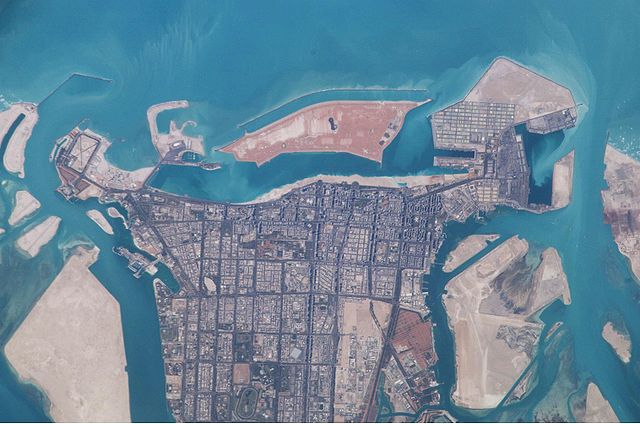capital city of the United Arab Emirates From Wikipedia, the free encyclopedia
Abu Dhabi (Arabic: أبو ظبي, ʼAbū Ẓaby) is the capital city of the United Arab Emirates. It is in the emirate of Abu Dhabi. Abu Dhabi is one of the seven emirates which form the United Arab Emirates(UAE). The city is on a T-shaped island going into the Persian Gulf from the central western coast. The city is 972 km2 in size. The city had a population of 1.45 million people in 2022. Abu Dhabi is also the capital of UAE and is the largest emirates in UAE.[1]




People started to live in the area and call it Abu Dhabi about 300 years ago. In the 1970s, the Bani Yas tribe made Abu Dhabi their capital city. Shakhbut bin-Dhiyab Al Nahyan became the leader of the city in 1818. People found oil in 1958 in Abu Dhabi. They started to sell the oil in the 1960s. In 1971 December the 2nd, Abu Dhabi joined the United Arab Emirates and became the capital city.
Abu Dhabi is in a desert and has a desert climate. There is not a lot of rain but it does rain a little in the winter months. The average rainfall per year is 51 cm. It can also be very hot. In the daytime, the average summer temperature is 42 °C. The average daytime temperature in the winter is more comfortable at 23 °C.
Abu Dhabi has many tourist attractions such as the Sheikh Zayed Mosque, Abu Dhabi Louvre Museum, Mangrove Kayaking Tours, Ferrari World, the Emirates Palace, Qasr Al-Hosn, bout towers, Abu Dhabi According to the Department of Culture and Tourism. The usual amount of people that come in Abu Dhabi is 10 million per year. Abu Dhabi also has Jabal Hafeet, which is the tallest mountain in the UAE.
Seamless Wikipedia browsing. On steroids.
Every time you click a link to Wikipedia, Wiktionary or Wikiquote in your browser's search results, it will show the modern Wikiwand interface.
Wikiwand extension is a five stars, simple, with minimum permission required to keep your browsing private, safe and transparent.